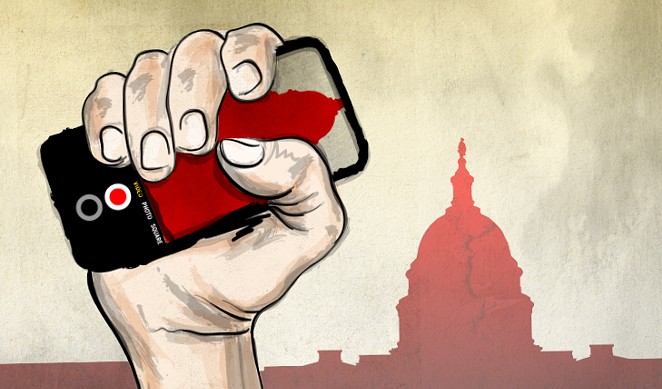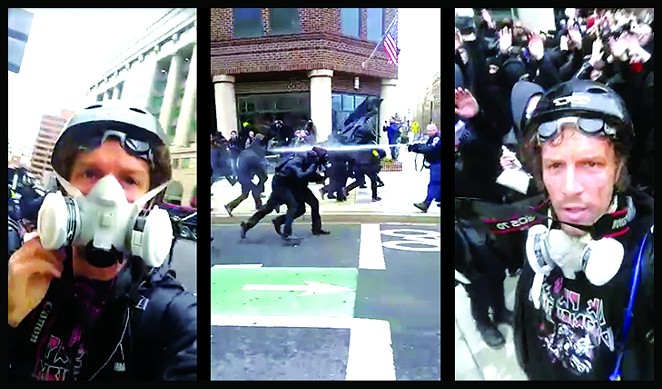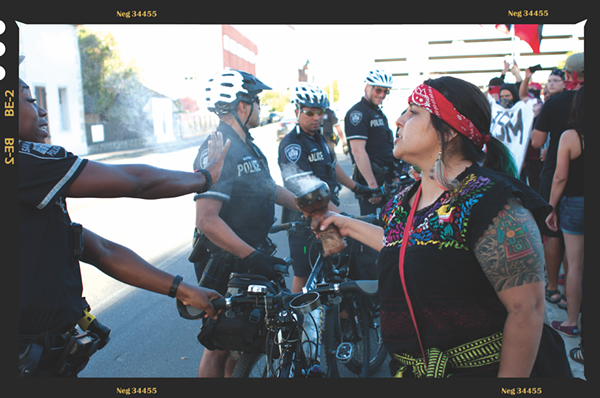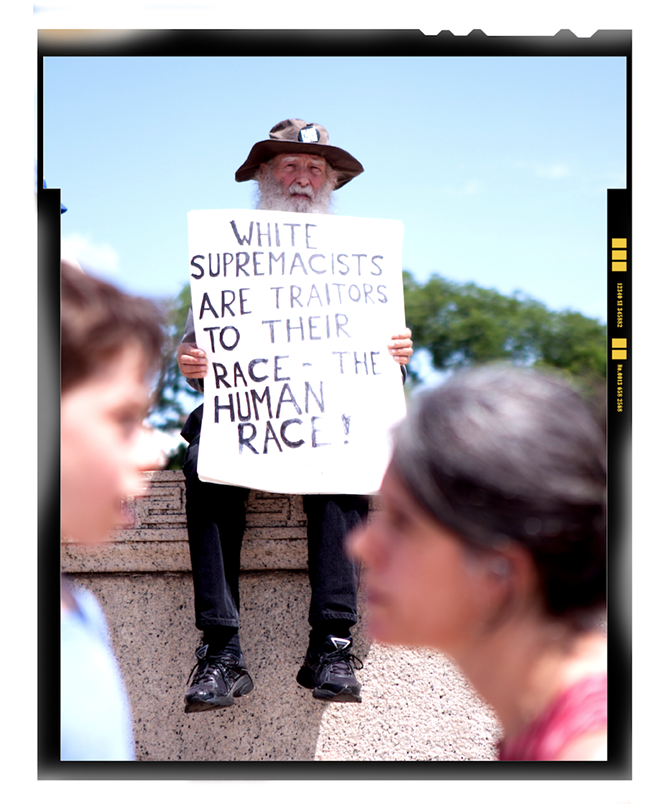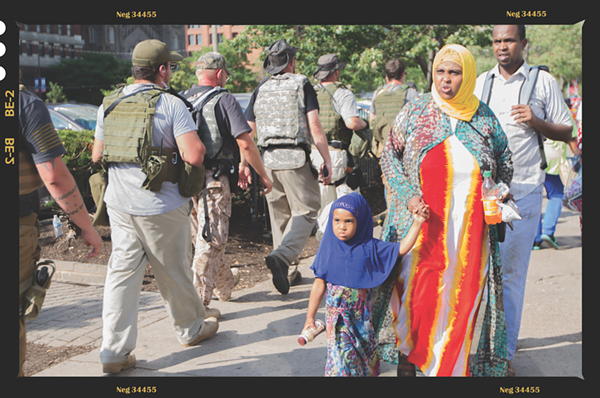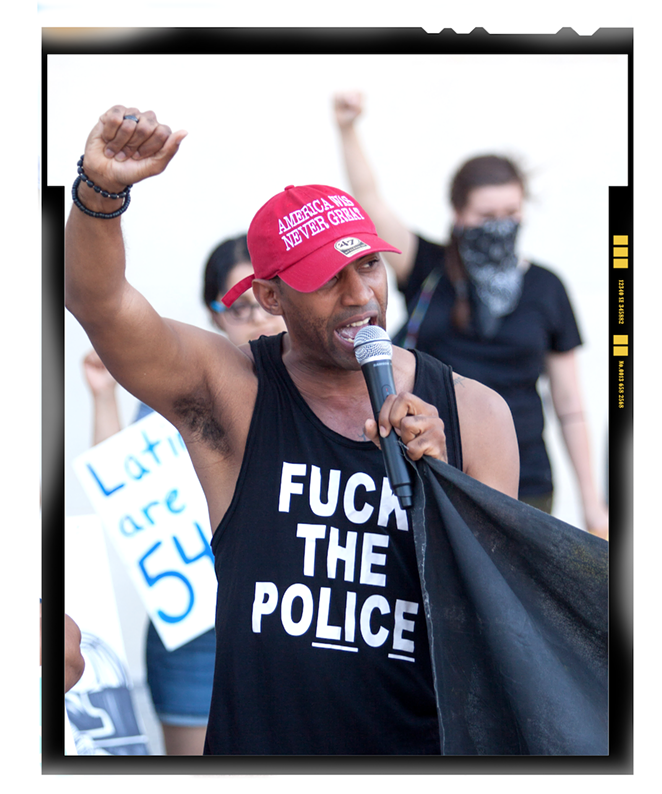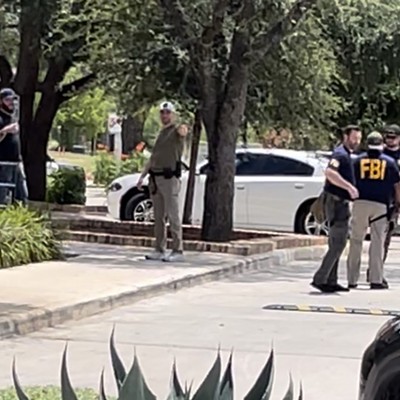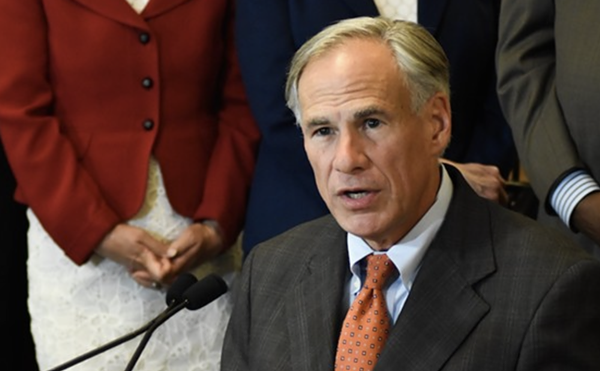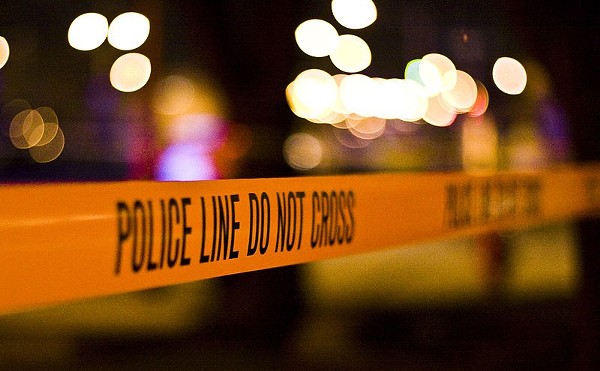A portion of Wood’s 42-minute footage resembles a war zone. At one point, after the sounds of another non-lethal grenade thwacked in and around D.C.’s Logan Circle neighborhood, an out-of-breath Wood says into his cell-phone video camera, “This is going to be a long day, y’all.”
Wood’s recording captures individuals clad in “black bloc,” head-to-toe black garb and wearing masks, spray-painting REVOLUTION OR DEATH on a slate gray grate and bashing out the windows of a limousine. On the corner of L and 12th streets, the dueling narratives between the protestors and the police collided, with members of each group sustaining injuries in various baton strikes, shoves and dogpiles. Wood, a 37-year-old freelance photographer and videographer, was there for it all, broadcasting live footage that dropped viewers straight into the heart of the intense scene.
But Wood paid a price for his in-the-trenches maneuvering. While on the frontlines of the clash between protestors and D.C. Metropolitan Police Department officers, armed riot cops deployed pepper spray and ensnared a group of more than 230 marchers and journalists, including Wood. Embattled MPD police chief Peter Newsham ordered the mass apprehension; the arrested were subsequently charged with felony rioting, which carries a statutory maximum of 10 years in prison and a $25,000 fine.
Felony charges were eventually dropped against a handful of the arrested journalists. But the opposite happened to Wood and 213 other arrested protestors and reporters.
The Superior Court of the District of Columbia smacked the defendants with a superseding indictment that tacked on charges of urging to riot, conspiracy to riot and destruction of property. The indictment says that, Wood, along with hundreds of defendants, took part in a 33-minute riot through 16 city blocks “to facilitate violence and destruction.” Wood, who on the day of his arrest carried an SLR camera in one hand and his cell phone in the other, said he didn’t destroy any property — let alone hurt anyone.
If convicted, Wood faces between 70 and 80 years in federal prison. Critics have called the charges “arbitrary” and “unbelievably harsh” while the MPD has been accused of using excessive force in a bellicose attack of basic First Amendment rights.
Wood said prosecutors offered him a plea deal of one year in prison deferred to one-and-a-half years probation, a $1,000 fine and 60 hours of community service, even though he doesn’t appear to come anywhere close to rioting or destroying property in court evidence, his Facebook Live video. He flat-out refused before hearing the details of the deal.
“I think these charges are just fucking absurd … I feel like I have an utterly strong case just like everybody else,” says Wood, who’s set to go to trial on November 20 on charges filed by U.S. Attorney Channing D. Phillips. “It was indiscriminate arrest. I’m ready to fight.”
Adds Brett Cohen, Wood’s legal counsel, “I probably won’t say much about the case at this time, other than to say his livestream of the incident speaks for itself.”
William Miller, a spokesperson for the Department of Justice’s U.S. Attorney’s Office, told the San Antonio Current that the department would not comment on a “pending case.”
And Dustin Sternbeck, director of communications at MPD, which has been condemned by the D.C. Mayor’s Office and various rights groups for its handling of the Inauguration Day arrests, refused to comment when contacted by the Current for multiple interview requests.
Though it’s unlikely that Wood will live the remainder of his life in jail for simply documenting a protest that lasted a whopping 33 minutes, that doesn’t excuse MPD’s grave missteps and the ensuing prosecutorial overreach, says Mara Verheyden-Hilliard, executive director of the Partnership for Civil Justice Fund. The D.C.-based group, which has sued MPD for protest arrest-related documents that the police department won’t cough up, has seen a growing trend of journalists getting swept away in mass arrests during free-speech rallies.
“This is an unprecedented attack against fundamental First Amendment rights, free speech, association and freedom of the press … what that means is for anyone who is marching in a First Amendment march, if somebody else commits a criminal act of property damage or other criminal act and you happen to be in proximity and presumably share a similar lawful political view, you will be charged with a crime. It’s extremely dangerous … it’s a form of collective punishment and it’s also illegal,” says Verheyden-Hilliard.
In the months after his arrest, the normally upbeat Wood, who has spent most of his life in Texas as a resident of Corpus Christi, Austin and, for the past four years, San Antonio, says that he has suffered post-traumatic stress disorder and depression.
“Weeks afterwards, I took a bite of a jalapeño and I had a full-fledged panic-attack flashback of getting pepper sprayed,” says Wood.
In his Inauguration Day protest video, Wood appears to be pepper sprayed. Because he and the other marchers had been standing quietly, waiting for an order to break up the march that protestors and critics say never came, he wasn’t wearing his gas mask.
He dropped to his knees, barely able to hang onto his phone that’s still live streaming to social media. “I know I’ll be OK,” Wood whimpered into the camera. “This is some of the worst pain I’ve had in my fucking life and it won’t go away.”
Wood, whose press pass dangles around his neck, struggled to move from his knees to a seated position as he barely grasped his cell-phone camera. The livestream picture jolted all over the place, to the boots of a police officer to the sidewalk.
The video abruptly ends.
The photographer never thought he would be arrested on January 20. Wood, whose resistance movement portfolio includes documenting protests of the Republican National Convention in St. Paul in 2008 and the 2009 G20 Pittsburgh summit as well as last year’s RNC in Cleveland and the Democratic National Convention in Philadelphia, says that he had never run afoul of the law to this extent.
“There was no order of dispersal [by law enforcement] and the mass of people showed no sign of resistance,” says Wood, who can be seen in the video, along with numerous others, with his hands in the air.
Trump’s swearing-in ceremony inspired protests en masse throughout the nation’s capital, many of which were arranged by the D.C.-based political group DisruptJ20 (or J20) and the antiwar and civil-rights organization the ANSWER Coalition, with voices ranging from LGBTQ allies and immigration rights advocates to animal rights groups and Dakota Access Pipeline protestors.
For the most part, the coordinated demonstrations throughout D.C., including the jam-packed Women’s March on Washington, were peaceful. But when black bloc protestors butted heads with law enforcement, all hell broke loose. The MPD said that at least six officers were injured during the protest, and according to the U.S. Attorney’s Office, local property, cars and buildings sustained more than $100,000 in damage.
Verheyden-Hilliard of the Partnership for Civil Justice Fund wonders why the police didn’t arrest the lawbreakers on the spot, instead of letting the destruction continue up until MPD formed a kettle — a technique used by law enforcement to confine a group of people with the aid of tear gas, pepper spray and other forceful displays. On July 17, the syndicated column Democracy in Crisis published chaotic body-cam footage from a motorcycle cop that appears to show officers hitting a man with a stick, shoving a protestor into a tree and pepper spraying the enclosed crowd.
“Why didn’t they arrest the people who were in front of them breaking windows instead of allowing it to continue and the group to move? The group is a fluid group, too, so people enter and leave the group. When you arrest people in an arbitrary time and place, you can’t say that that’s the same composition that existed at an earlier point of the march,” says Verheyden-Hilliard.
A month after the arrests, the D.C. Mayor’s Office concluded that officers used indiscriminate force without justification and failed to bark dispersal orders to the crowd. In June, the American Civil Liberties Union filed suit against the City of D.C., MPD and Chief Newsham, and accused D.C. law enforcement of “making wrongful arrests, violating protesters’ constitutional right to free speech, denying detainees from accessing food and water and carrying out invasive body searches.”
According to U.S. News and World Report, the U.S. Attorney’s Office, after reviewing law-enforcement evidence, dropped the original charges against independent videographer Matt Hopard, Alex Rubinstein of Russia Today America and documentary filmmaker John Keller approximately 10 days after the January 20 mass arrest. It remains hazy why Wood and the other journalists who were charged in the superseding indictment weren’t subjected to the same treatment.
Some J20 defendants aren’t waiting for the results of messy investigations and complicated lawsuits. On May 26, lawyers for 30 of the defendants filed a motion in D.C. Superior Court to dismiss the charges of the superseding indictment, which carries what amounts to a life sentence in prison for a number of the defendants.
However, on July 14, U.S. attorney Phillips opposed the motion, all but guaranteeing a laborious, exhausting legal battle for those who haven’t voluntarily, or unwillingly, accepted plea deals.
Wood caught his big break four years ago when a nonprofit sent him to Africa on a three-week assignment that included documenting African students traveling throughout Kenya and Tanzania — including a hike to the top of Mount Kilimanjaro. When that assignment ended, he stuck around Africa for 10 more months, picking up additional photography work for non-government organizations and shooting in Kenya, Tanzania, Malawi, Zanzibar and South Africa. In July 2013, he documented Zimbabwe’s President Robert Mugabe’s supercharged and scandalous re-election campaign.
“It was the first time I was truly scared to be a journalist,” says Wood, “but now that I’m facing 70-plus years in prison for documenting protest to the Trump regime, it obviously wasn’t the last time I’d be scared.”
The next court date for the J20 defendants, a status hearing for motions for dismissal before Judge Lynn Leibovitz in the Superior Court of D.C., is scheduled to take place at 10 a.m. on July 27.
On July 7, Leibovitz sentenced Dane Powell, a 31-year old military vet of Tampa, Florida, to 36 months in prison for his actions during the black bloc march, but suspended all but four months of his term if he successfully completes two years of supervised probation. Powell, who was found guilty of breaking windows and chucking rocks, had pled guilty to two felonies in April.
“I am still waiting for the final [known] part of discovery from the government before filing motions with the court to dismiss the case and to have Mr. Wood’s matter tried alone,” says Wood’s lawyer Cohen, who’s based out of Bethesda, Maryland.
Meanwhile, more than 130 defendants, including Wood, have banded together in the “Points of Unity” agreement spearheaded by the Dead City Legal Posse, a DisruptJ20-affiliate that provides legal support for activists. The collective pledge rebuffs any potential plea deals offered to the defendants and shuns cooperation with prosecutors who seek evidence that might harm another J20 defendant’s case.
As Wood’s trial draws closer, his world has been dominated by legal burdens and follow-up court appearances. He’s already flown to D.C. twice for court appearances — and will tack on at least two more round trips for the case. He’s considering crowdsourcing to help pay his travel expenses, and even reached out to friends to see if they’d be willing to pass along extra airline miles.
“Some days I feel confident, but other days I realize that I’m facing three felony rioting charges and five felony property destruction charges. Since my arrest, I’ve gotten all of these white hairs and I’m losing weight,” says Wood.
He was hesitant to cover another protest out of fear of arrest and police, but got back into the game during the local May Day protests organized by San Antonio labor unions and social-justice groups. “Loud noises and just police in general make me nervous, but ultimately I’m not in fear.”
Asked if he would do it again, with full knowledge that he could possibly be serving a lifetime in federal prison, Wood pauses for a moment before finally saying, “I literally got to the frontline basically the entire time and I don’t regret that. I just don’t regret that.”

